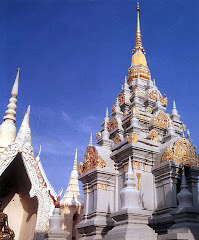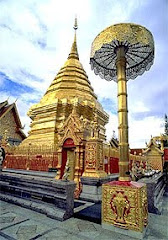 |
King Rama III
Phra Nang-Klao, the third of the Chakri dynasty, succeeded his father in B.E. 2367. Having a natural bent for architecture besides being a pious king himself, he had more temples built both inside and outside Bangkok. The temple of Jetuvana in the reign of King Rama I became a treasure of religious knowledge for Buddhist scholars and the symbolic “Prang” of Bangkok was perfectly completed in his reign. Also two groups of good-will missionary bhikkhus, one after the other, were sent to Ceylon. His piety in Buddhism may be seen in his pioneer undertaking to translate the Pali Tipitaka and some other Pali texts into Thai. Nevertheless, his reign came to an end before they were all completed.
In B.E. 2372 there was a religious movement which marked a cornerstone for the study and practice of Buddhism in Thailand, ---- the birth of the Dhammayutta group of bhikkhus. This was due to Prince Mongkut, the King’s younger brother who had been ordained as a bhikkhu for 27 years. Through this long period of secluded life he was endowed with a thorough knowledge of the Buddhist Scriptures, including the Tipitaka, its Commentaries, Sub-commentaries and other Pali texts as well. With such a wealth of knowledge gained and digested as a result of long and profound thinking, he was able to distinguish more clearly between what is right and what is wrong in the Master’s doctrine. He then set out putting to practice what is mentioned and regarded as righteous in the Tipitaka. By doing so, he unwittingly made a great impression on those who, inspired by his conduct, took it upon themselves to follow his way of life. This group of people, in course of time, grew bigger and more popular and became a separate gathering of bhikkhus called the Dhammayutta group as distinct from the former group of bhikkhus in Thailand. Besides being proficient in religious knowledge, Prince Mongkut also had a good command of Sanskrit and English , and in his establishing the Dhammayutta group of bhikkhus, his movement might be compared with that of the Venerable Rahula Thera who through his examplary mode of practice had founded the Lankavangsa group of bhikkhus at the town of Nakhorn Si Thammarat (some 800 km. south of Bangkok).
Of the religious literature in Thai, one was “Pathom-Som-Bodhi-Katha” (life of Buddha) compiled by the Supreme Patriarch Prince Paramanujit Jinorasa of Jetuvana Temple. Of the works in Pali, one called “Sima Vicarana” (Treatise on Sima or boundary of a main shrine) compiled by Prince Mongkut himself wins high respect in Ceylon.
Technorati tags : Ratanakosin Period /Thailand Temple /Buddhism /thai temple /Bangkok








No comments:
Post a Comment